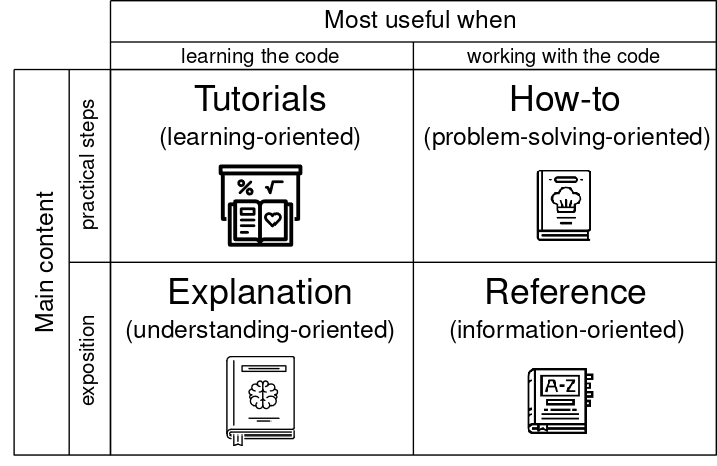Documentation: Design#
We believe that documentation is essential to the on-going development of any software. Good documentation helps users and contributors–including ourselves–navigate the steep learning curve of using and contribution to Minterpy. That’s why we invest significant time in developing and improving the documentation.
On this page, you’ll learn more about the underlying design of the Minterpy documentation.
Design principles#
There isn’t just one documentation but four, each serving a distinct purpose. We follow this documentation design principles from Diátaxis to structure the Minterpy documentation. The four different categories of documentation are:
The distinction between these categories is summarized in the table below.
Category |
Orientation |
Main content |
Most useful when… |
Think of… |
|---|---|---|---|---|
Tutorials |
Learning |
Practical steps |
learning the code |
Lessons |
How-to |
Problem-solving |
Practical steps |
working with the code |
Recipes |
Explanation |
Understanding |
Exposition |
learning the code |
Textbooks |
(API) reference |
Information |
Exposition |
working with the code |
Dictionary |
Or if you’re more visually-oriented…

Fig. 12 Four distinct categories of documentation (adapted from the Diátaxis).#
See also
We encourage you to read through the design as outlined in the Diátaxis and watch a talk by the author Daniele Procida in Pycon 2017.
The main sections of the Minterpy documentation directly reflect all these four categories. Additionally, we have a special section for contributors called the Contributors Guide, which primarily contains how-to guides tailored for contributors rather than users. Each addition to the documentation should be clearly assigned to a single category.
Tutorials#
Tutorials are learning-oriented documents; think of them as lessons for Minterpy users. In a tutorial, the tasks should be meaningful and the outcomes should be immediate, while avoiding unecessary explanations, jargon, and technical details–especially in the beginning. They should have a minimal, but non-trivial, context. Writing tutorials is challenging; you need to select a problem that is relatively easy yet non-trivial and carefully introduce important and more advanced topics as the tutorial progresses.
Well-curated tutorials are a crucial, if not the most important, element of the documentation for onboarding both users and contributors. The offer a glimpse of what Minterpy can do and how to use it as intended.
We organize all tutorials inside the Getting Started with Minterpy and list them in order of difficulty. This section includes a quickstart guide and a series of in-depth tutorials.
How-to guides#
How-to Guides are problem-solving-oriented documents; think of them as recipes for performing specific tasks with Minterpy. Each guide provides step-by-step instructions for solving a clearly defined problem. These guides are largely context-free, assuming that users who have some proficiency with Minterpy are seeking solutions to common, specific issues.
Writing how-to guides is somewhat easier than writing tutorials, as the problems are more well-defined, context-free, and tailored for users with assumed proficiency.
We organize all how-to guides inside the How-to Guides, grouping them by common tasks involving Minterpy objects or numerical tasks (e.g., interpolation, regression, differentiation, integration).
Explanation (fundamentals, theory)#
Explanation or fundamentals are understanding-oriented documents; think of them as the theoretical expositions (like those found in textbooks) of the mathematics underlying Minterpy. A fundamentals section provides the context and background of Minterpy, detailing the different layers of abstraction from the top down and explaining why things work as they do. They avoid instructional content and minimize descriptions related to the code implementation.
We write the fundamentals section of the documentation to help users and contributors understand Minterpy and its underlying concepts more deeply. The fundamentals section is crucial for advancing users and contributors: a user might become a contributor, and a contributor might improve their contributions by understanding the theory behind Minterpy better.
Writing a fundamental section is challenging because the topics are more open-ended. You need to decide what to explain, how deep is your explanation, and where to conclude.
We organize all theoretical topics related to Minterpy within the Fundamentals of Minterpy.
API reference#
API reference is an information-oriented document; think of it as a dictionary or an encyclopedia [1] that describes all the exposed components and machinery of Minterpy. The API reference avoids explaining basic concepts or providing extensive usage examples; its main focus is to describe. This type of documentation is particularly important for advanced users and contributors.
The API reference documentation tends to be terse and follow a well-defined, consistent structure. It often has a nearly one-to-one correspondence with the codebase itself. If you’re a developer, you’re likely already familiar with creating the API reference (e.g., for modules, classes, functions).
We organize all references for the exposed Minterpy components within the API Reference.
Contributors guides#
Contributors guides are documents intended for, well, contributors. They primarily consists of how-to guides for contributing to the Minterpy project, either to its codebase or documentation. They also include meta-information about the project’s organization, history, and the people behind it.
We organize all guides for contributors within the Contributors Guide.
Summary#
The Minterpy documentation is currently organized into five main sections:
Getting Started with Minterpy (including a Quickstart Guide and a series of in-depth Tutorials)
These sections align with the documentation design principles from from Diátaxis, which identifies four distinct types of documentations:
Now that you understand how we’ve designed the documentation, you might be interested in learning more about how we build it.
Footnotes
